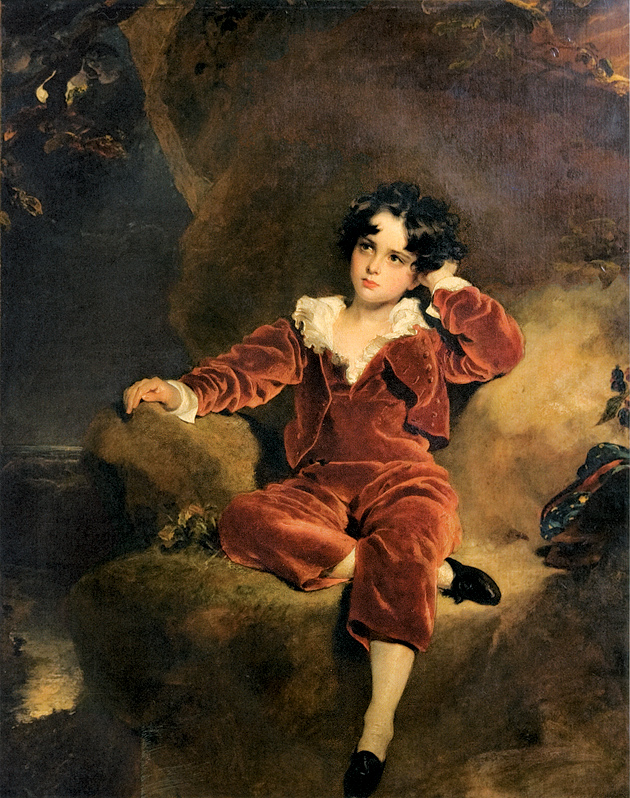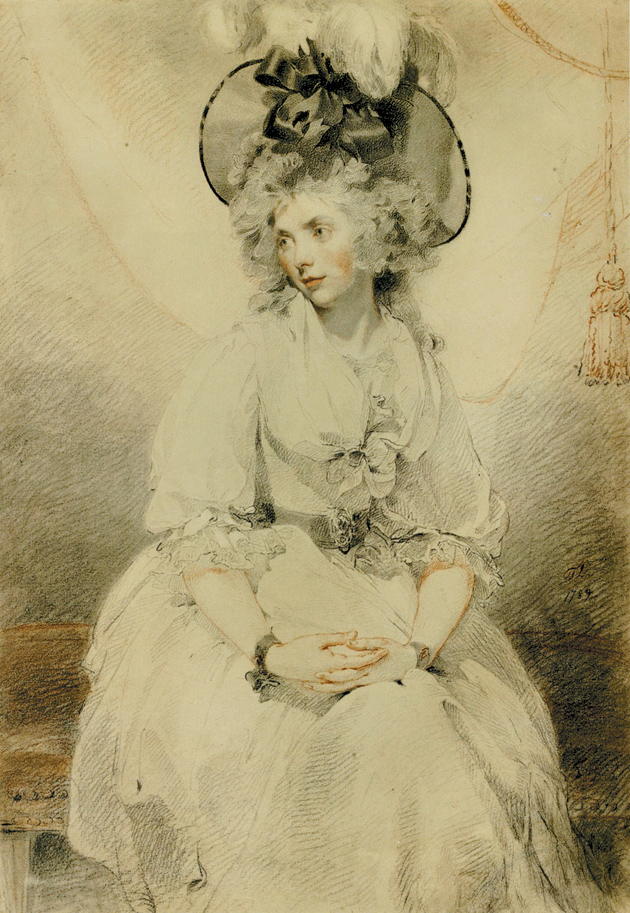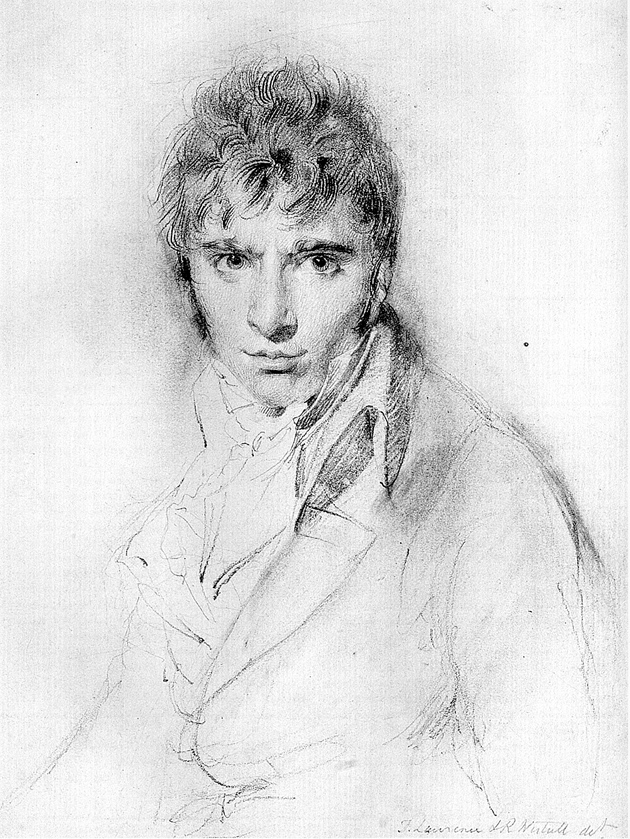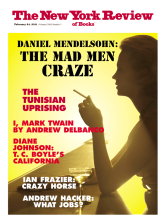Sir Thomas Lawrence (1769–1830) belongs to the genial “Golden Age” of British portrait painting—the age of Gainsborough, Northcote, Hoppner, Phillips, Beechey, and Sir Joshua Reynolds. But he also bears the intriguing distinction of having been accused of inventing the Chocolate Box School of Regency portraiture.
His luscious treatment of edible young Regency debutantes, sugar-frosted grenadiers, and apple-cheeked babies has frequently provoked sly amusement, if not outright derision. His jealous contemporary Benjamin Robert Haydon observed: “Lawrence…was suited to the age, and the age to him. He flattered its vanities, pampered its weaknesses, and met its meretricious taste.”
One of his most famous paintings, Charles William Lambton, subsequently known as The Red Boy (1825), has frequently graced tins of toffees and shortbread, and in 1969 appeared on the British 4d postage stamp. Wordsworth, the great poet of remembered childhood, said of The Red Boy when it was first exhibited: “Lawrence’s portrait of young Lambton is a wretched histrionic thing; the public taste must be vitiated indeed, if that is admired.” A recent art critic in the London Observer noted dryly: “Lawrence painted children the way Disney does deer.”
This trail of mockery has pursued Lawrence into the twenty-first century. It has been said that his only true artistic successor was the raffish fashion photographer Cecil Beaton. Even the mild-mannered Oxford History of Art: Portraiture (2004), by Shearer West, chose to praise Lawrence by burying him. Though there are thirteen references to his immediate predecessor Sir Joshua Reynolds, Lawrence’s name does not even appear in the index.
The dazzling new exhibition “Thomas Lawrence: Regency Power and Brilliance,” at the Yale Center for British Art in New Haven, has set out to change all this. It originates from the National Portrait Gallery, London, where it was a startling success last autumn, perhaps partly in reaction to the general mood of financial gloom and gray recession. Just walking into the gallery from a bleak, rain-swept Trafalgar Square was a hugely cheering experience. Lawrence’s pictures flooded the rooms with color, energy, and spectacular self-confidence. Viewers were observed to walk out with a new spring in their step; and one in three with this new expensive catalog under their arm.
The exhibition sets out to show how Lawrence defined and celebrated the most exuberant aspects of the English Regency: its flamboyant high society, its glittering soldiers and statesmen, its glamorous women, its elegant actors and dandies, and—yes—its well-fed children. (No room for the poor, maimed, or starving, though this of course was the period of the Napoleonic Wars and its aftermath.)
The catalog is one of the most splendidly illustrated I have ever seen, with over seventy full-page plates, and numerous details and drawings. These are accompanied by three fine critical essays: a subtle exploration of Lawrence’s changing ideals of Regency “masculinity” (from the foppish to the martial) by Peter Funnell of the National Portrait Gallery; a scholarly defence of Lawrence’s child portraits and the shifting historical conventions of “innocence” (drolly entitled “‘Charming Little Brats'”) by Marcia Pointon; and a wonderfully deft and perceptive analy- sis of Lawrence’s female portraits, by a curator of paintings and sculptures at the Yale Center, Cassandra Albinson.
Albinson’s essay is carefully titled “The Construction of Desire.” It reveals hitherto quite unexpected depths in Lawrence’s play between ideal mythic women (Psyche, the Sibyl) and his actual, extremely worldly sitters, like the actress Sarah Siddons, the notorious Countess Blessington, or Lady Frances Hawkins, the gorgeous Irish mistress of his friend Lord Abercorn. It meditates tactfully on “the conflicting messages of brazenness and softness.” There are brilliant passages on Lawrence’s brush techniques, such as his special method of illuminating female eyes, his way of capturing a flirtatious gaze, or his “flurry of white highlights” on romantically disordered hair, which “indicate visually the underlying inti- mate encounter between artist and sitter.” As the banker-poet Sam Rogers was rumored to have quipped: “If I wanted my mistress painted I would go to Lawrence; if my wife, I would go to [Thomas] Phillips.”
Lawrence himself was no product of the London high life. He was born in Bristol in April 1769, the son of a tavern keeper, and grew up at his father’s celebrated coaching inn, the Black Bear, on the Devizes road in Wiltshire. A beautiful and gifted child, he was considered a prodigy by his parents, able to recite Milton’s Paradise Lost, act scenes from Shakespeare plays, and dash off astonishing pastel drawings of his father’s customers as they sat at table, all by the time he was five years old.
His instinctive skill as a draftsman at catching “likenesses” of his father’s customers (it was noted that he usually took “about seven minutes”), especially the fashionable female ones, was soon remarked on by influential visitors, such as the novelist Fanny Burney. So too was his precocious ability to charm and seduce. By the time Lawrence was ten, his father was already charging for the boy’s drawings and pastels.
Advertisement
When Lawrence was eleven, his father went bankrupt. More keen than ever to exploit his gifts, his parents took him first to Oxford and then to fashionable Bath (the city of Beau Brummell), where characteristically he caught the attention of both Sarah Siddons and the fashionable socialite the Duchess of Devonshire. One begins to sense the kind of obsessive parental grooming that we might now associate with a young tennis star.
Next his parents launched him in London, from rooms off Leicester Square, at the age of seventeen. Here he met the aging president of the Royal Academy, Sir Joshua Reynolds, who took one look at his portfolio and immediately prophesied a great future: “In you, sir… the world will expect to see accomplished what I have failed to achieve.” Lawrence briefly attended the Royal Academy Schools, but it is thought this apprenticeship lasted less than three months—the only institutional training he ever had.
From then on Lawrence’s professional success was meteoric. He was elected associate of the Royal Academy of Arts at the age of twenty-two, Painter-in-Ordinary to King George III at twenty-three, a full member of the Royal Academy at the age of twenty-five, made a baronet in his mid-forties, and elected president of the Royal Academy in 1820 at the age of fifty-one. His earliest pastel portraits at the Black Bear Inn had been sold for half a guinea. Some of his last portraits in oils went for nine hundred each.
Lawrence had almost no serious artistic apprenticeship as a boy. Yet one of the most striking revelations of the exhibition is that, from the very beginning, he was a brilliant delineator of the human face in chalk, crayon, pencil, or pastel. His drawings were from the start confident, exuberant, and above all witty. Later they also became psychologically acute, subtle, and tenderly empathetic.
There is no real explanation of this phenomenon, though one is reminded that this was, after all, the age of youthful genius par excellence: Chatterton, Coleridge, Byron, Shelley, Keats, even the chemist Sir Humphry Davy. (Davy’s career pattern in science was almost exactly parallel to Lawrence’s: he became president of the Royal Society in 1820, and indeed was painted appropriately by Lawrence to celebrate that very achievement.) In fact Lawrence had already been mentioned in an essay on “child prodigies” by the critic Daines Barrington as early as 1781.
What he was already capable of is shown by the exquisite, witty, sophisticated drawing of his early friend and mentor Mary Hamilton and her amazing Bo-Peep hat. It was executed by Lawrence in 1789, at the age of nineteen, when he was first starting to exhibit at the Royal Academy. It is part fashion plate and part romantic mood study. To the fine mesh of black chalk, he has added flushed highlights in red (a favorite technique), like too much excitement rising into her lips and cheeks. The effect is deliberately theatrical, dressy, and provocative. Mary’s pose is self-conscious, and curiously teasing. It may be inspired by the pre- Revolutionary aristocratic fashion for playing pastoral shepherdesses, much favored by Marie-Antoinette. But it could also be a sly satire on them (the Bastille fell this year). In fact, is the beautiful Mary Hamilton about to burst out laughing?
A similar, teasing ambiguity attends his strange and wonderful drawing of Mrs. Papandriek (1789). It was executed at Windsor Castle, where Lawrence was officially painting the aging Queen Charlotte. Refused further sittings by the impatient and irritable monarch, the ever-resourceful Lawrence asked her young lady-in-waiting Mrs. P to model the royal jewels, posing with bare arms in an anteroom. To amuse the pretty Mrs. P, and probably to flirt with her as well, Lawrence suggested she put on her most fashionable hat and bring her little boy for his portrait too. The result is a brilliant, witty study in Regency style and manners that prompts the question: Is Mrs. P more proud of her child or her hat? Is motherhood or millinery more important?
For the first seventeen years in London, between 1788 and 1805, Lawrence’s portraits were continuously prominent at the Royal Academy exhibitions. Although sometimes mocked and criticized, he continued to develop this new Romantic look. He plunged into the heady Regency world of aristocracy, fashion, and theater, but also found time for striking pieces of political reportage, such as his remarkably dramatic drawing of the young radical Thomas Holcroft and his supporter, the anarchist philosopher William Godwin, at the treason trials in the Old Bailey in 1794. Again, Lawrence has chosen an intensely theatrical moment: Holcroft—on a capital charge—has just been found not guilty. Male friendship in adversity had great emotional significance for Lawrence, and the double portrait became a favorite motif.
Advertisement
For the young women of the time, Lawrence’s sense of Romantic style and flamboyance often outran the tastes of even the most fashionable. The dazzling, airy portrait of the thirty-year-old actress Elizabeth Farren announced his triumphant arrival at the Royal Academy exhibition of 1790. Her fresh, seductive figure is offset by an astonishing and provocative display of textures: muslin, fur, satin, and silk, and above all perhaps her limp, languorous, chamois gloves. Each is rendered with sharp, voluptuous appreciation.
During these same momentous years, following the French Revolution and the declaration of the Napoleonic Wars in Europe, Lawrence also identified a new, swaggering masculine style emerging among the young men of the Regency. Significantly it was “Byronic,” some ten years before Byron actually adopted it himself. Dark, dandyish, dashing, brooding—as in his explosive sketch of his fellow artist Richard Westall—it combined an extraordinary mixture of male arrogance and almost feminine beauty, emphasized by vivid clothes, peacock hairstyles, and smoldering glances.
Here Lawrence was painting his own generation, and effectively bringing it onto the stage of history. The images are powerful, confident, and confrontational. He supplied them with stormy or melodramatic backgrounds, dashed in with fast, free brushstrokes, as if liberating them from an old world of conventions. In contrast with the previous generation of artists—the smoothness of Reynolds or the feather-light touch of Gainsborough—he rendered their clothes with thickly applied paint, strongly contrasted colors, and glittering, almost metallic, highlights. With these techniques, Lawrence expressed a new age of patriotism, flamboyance, and bold individuality.
For all the wonderful extravagance of his portraiture, Lawrence’s own life appeared—on the surface at least—curiously reserved and restrained. He repeatedly said he never bet on cards, never gambled on horses, never got drunk with friends (all proper Regency male pastimes). Instead, he claimed his favorite reading was Jane Austen, and his most extreme sport was billiards. He never married. Yet he was handsome, flirtatious, and charming to a perilous degree. His great friend and confidant, the painter and diarist Joseph Farington, bluntly called him a “male coquet.” But this does not seem quite to explain the case. An anonymous female admirer wrote more perceptively:
He could not write a common answer to a dinner invitation without it assuming the tone of a billet-doux: the very commonest conversation was held in that soft, low whisper, and with that tone of deference and interest, which are so unusual, and so calculated to please.
A male friend called him simply an “old flirt.”
This insidious gift for intimacy, for making everyone feel special, which Lawrence practiced on both his male and female subjects, was evidently an essential part of his magic as a portrait painter. It was his actor’s ability to enter into all their characters and moods; and also that instinct to charm and flatter, which he had learned as a child. His drawings expressed this same swift and sometimes teasing empathy; while his paintings added those theatrical elements of glamour and gusto that became his trademark.
In an unexpected moment of self- revelation, Lawrence once described his own character as “Genius…infected by Romance, and wasted by Indolence and Languor.” He added that he had the mark of “the Voluptuary,” and that playing around his mouth were “Passions powerful to ruin, to debase, or to elevate the Character.” As suits a Romantic figure, there remains a kind of mysterious doubleness about his identity, a secretive and possibly bisexual quality that runs both through his life and through the ironic subtext of many of his portraits. He once wrote a curious little camp poem, “On Being Left Alone after Dinner,” which contains the lines: “I wish the sex were kinder grown,/And when they find a man alone,/Would treat him like a woman.”
In 1797, when both his adoring parents suddenly died, he had some kind of emotional breakdown, embarked on a hysterical affair with both of Sarah Siddons’s daughters simultaneously, threatened suicide, and produced his extraordinary androgynous drawing Satan as the Fallen Angel. Subsequently Lawrence was the subject of endless tattle and gossip, and his name was linked romantically with many of his sitters (although only the female ones), from the Duchess of Devonshire to the unhappy Queen Caroline. (Indeed Lawrence had to sign a legal deposition disclaiming adulterous opportunity, before Caroline’s trial for divorce in Parliament).
Most mysterious of all was the beautiful Isabella Wolff (another divorcée). Isabella may indeed have been his mistress, and her stunning silvery portrait—the most Sibylline he ever painted—conveniently took Lawrence some thirteen years to complete. Albinson shrewdly points to Isabella’s luxurious midriff in the picture—“the painting betrays an anxiety about pregnancy and generation”—and even suggests they had a child together, Herman St John Wolff, though the documentation remains inconclusive.
Another mystery was Lawrence’s finances. Despite his ever-increasing fees, Lawrence remained in debt for his whole life. By 1807 his bankers, Coutts, reckoned he owed some £20,000. Exactly what he spent his money on remains an enigma. Perhaps it was his excellent collection of Old Master drawings—eventually sold to Queen Victoria to pay his creditors long after his death. His friend Farington mildly suggested that he was no good at accounting for his money, and probably gave much of it away.
Certainly Lawrence had an acute and generous eye for fellow artists, and his letters show the encouragement and support that he gave to J.M.W. Turner, Richard Parkes Bonnington, the naturalist John James Audubon, and the poet and engraver William Blake. In fact Lawrence was one of the very few contemporaries who praised and actually purchased a copy of Blake’s Songs of Innocence and of Experience. He also kept a copy of Blake’s drawing The Wise and Foolish Virgins on a special table.
His studios were always ultra- fashionable. His first, at 41 Jermyn Street, is now appropriately occupied by the tradesman’s entrance of Fortnum & Mason. The demand for portrait sittings was as relentless as consultations with a modern Harley Street specialist (and similarly priced). Lawrence would undertake as many as five two-hour sittings a day, charging a 50 percent deposit. Consequently, much of his correspondence was concerned with the failure to deliver finished portraits, sometimes drawn out over many years. Lord Ellenborough once threatened to prosecute him in the courts for refusing to complete a painting of his wife. Another aggrieved client challenged Lawrence to a dawn duel in Hyde Park.
Alfred, one of Lawrence’s most faithful assistants, slyly suggested that unfinished portraits had their own uses, especially with female clients of a certain age:
Some of them do come in a huff, but they always go away pleased, for my master brings out the picture, and says it needs only be altered in the dress, and then they think they are handsomer than ever. One old lady came the other day and asked to see a picture of her begun twenty years ago…. Do finish it Sir Thomas, it is such an excellent likeness.
Much changed for Lawrence after 1810, with the death of his arch-rival, John Hoppner. He soon executed his first portrait of the Prince Regent (later George IV), became the official court painter, and moved into grandiose apartments in Russell Square. In 1814 he was commissioned by the prince to paint all the European leaders of the wartime coalition against Napoleon. This took him intermittently to Paris, Vienna, and Rome over a period of some five years. He embarked on his huge, ambitious portraits of the mighty soldiers, statesmen, monarchs, clerics, and self-important princelings of the age, and these made him an international star. He was knighted, and began to move in exalted social circles, hobnobbing with the grand and wealthy, and writing long, excited letters to Mrs. Wolff about it all. He was elected president of the Royal Academy in 1820.
To this heady period belong the great series of “swagger portraits,” as they were once dismissively called. Here Lawrence’s natural sense of theater and dynamic style strive for a new dimension of historic resonance. Three of these enormous portraits, each about nine feet tall, were exclusively on loan from the Waterloo Chamber, Windsor Castle, where they form part of the Royal Collection. Sadly they have not made it to Yale, but are superbly reproduced in the catalog.
Each is closely associated with the defeat of Napoleon on the battlefield. One can practically hear the martial roar of Field Marshal von Blücher sending his troops into the fray, while the quiet, resolute elegance of the Archduke Charles of Austria commemorates one of the master strategists of the allied coalition. Both are still swathed in the smoke of battle, glamorously celebrating a defining, international victory. But perhaps most subtly impressive of all is the shrunken figure of Pope Pius VII, the man who endured Napoleon’s prisons for four years but survived as a moral center of European opposition and eventually brought back all the plundered art treasures to Italy. It is a complex, masterly study of both fortitude and cunning.
On his return home, Lawrence performed the same magical stagecraft on government figures such as the Duke of Wellington, Sir Robert Peel, and George Canning. Although sometimes undoubtedly stagy, they reflect the rhetoric of the Regency, and serve their proper purpose as official “portraits of record,” splendid and monumental. Lawrence’s original, graphic genius wonderfully informs the best of these later works. It is fascinating to see how the fixed, hawk-like glare of his hypnotic portrait of Wellington has emerged from the softer and more psychologically subtle drawings of the same subject.
Lawrence’s old sense of freedom and daring was developed even more fully in his later portraits of women. He had previously shown the glowing sexual radiance of Frances Hawkins, shamelessly reflected in the hot, loving glance of her illegitimate child and the panting of her large pet dog: a kind of triangular circuit of passion. Now he gave the pert, seductive charm of Lady Selina Meade, the arch amusement of the Princess Sophia, or the tender, teasing melancholy of Rosamund Croker a rich and sumptuous life all their own.
The ravishing portrait of Margaret, Countess of Blessington (originally a penniless beauty just like Nelson’s Emma Lady Hamilton), is one of the most glorious, brazen pictures Lawrence ever painted. Lord Byron, when he first met Lady Blessington in Italy, instantly identified her as the subject of Lawrence’s picture and the archetype of the English Regency belle. All London was “raving” over it, and over her, the author of Don Juan noted appreciatively. Even better, she gave his own mistress, Countess Guiccioli, “a furious fit of Italian jealousy.”
When Lawrence first began to exhibit in Paris, toward the end of his meteoric career in the legendary “English” Salons of 1824–1827, he was greeted as one of the great, liberating harbingers of British Romanticism, and awarded the Légion d’Honneur. He was seen as part of that movement that overturned all the old restrictions of classicism: the poetry of Lord Byron, the experimental science of Sir Humphry Davy, the novels of Sir Walter Scott, the landscapes of Constable, and the portraits of Lawrence. “The English manner enjoys a triumph in Paris,” wrote the young Stendhal, “Mr. Lawrence’s name is immortal.”
Lawrence’s pictures of women, and of children, took his viewers by storm. His ebullient picture Laura Anne and Emily Calmady, in which the youngest girl is practically kicking out of the picture frame, suggested a whole new uninhibited approach to childhood. Jean-Jacques Rousseau was vindicated.
Delacroix enthused: “Nobody has ever painted eyes, women’s eyes particularly, so well as Lawrence…. He is inimitable.” Lawrence himself, contrary to any idea of easy facility, always spoke with disarming modesty about his own art of portraiture, which he felt he had never entirely mastered: “I am perpetually mastered by it…as much the slave of the picture I am painting, as if it had living, personal existence, and chained me to it.”
And as for The Red Boy in his scarlet velveteens? From the superb catalog we learn that he is not simply the beautiful chocolate box child, as so easily assumed. In fact he is a beautiful doomed child. Charles Lambton would die aged thirteen. He is a child who will never live to grow up. Moreover we learn that he was quickly assumed to be an imaginary portrait of the dreaming youthful Byron, the very soul of English Romanticism. This was partly why he was reproduced across Europe, and then America, as a symbol of eternal hope and youthful promise. If that is chocolate box, it may be exactly what we need right now. “Thomas Lawrence: Regency, Power, and Brilliance” is a wonderful, inspiring exhibition.
This Issue
February 24, 2011






